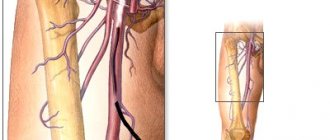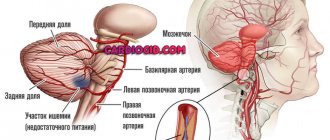Structure of the vascular system
The blood supply to the ovary is realized due to the different directions of flow and outflows, which deplete the arteries, veins and their plexuses.
The vascular system of the ovaries can be divided into internal and external. The latter consists of arteries that are located between the large abdominal vessels and the main entrance to the ovary. The other contains arteries that lead to the ovary, creating a microcirculatory network that transfers blood flows to the venous system of the glands. The transformation of vascularization of a cyclic type is especially pronounced in the work of internal systems. The ovaries are supplied by two passages:
- Ovarian artery,
- Ovarian branch of the ascending uterine artery.
By anastomosing, these arteries create a kind of arch along the gate of entry into the ovaries and form the vascular ovarian arches. From the arch stretch vessels that run through the stroma of the medulla, heading to the periphery of the ovarian cortex and are located in its stroma, surrounding each follicle.
During the ovarian cycle, connective tissue called the theca (envelops the vascular layer of granulosa cells of the follicles) fills with capillary plexuses. Visualization of vessels in this part of the ovary is possible with ultrasound using colorectal dosage during the proliferative phase of MC.
We recommend learning: Phases of the ovarian cycle
Ways to improve blood circulation in the pelvis
To know how to deal with a disease, you need to have information about the causes of its occurrence. It is advisable to immediately find out about the consequences so that you have more motivation to work on yourself: change your lifestyle, increase physical activity, monitor your diet and immunity. Poor blood circulation is caused by:
- problems with blood vessels;
- problems with immunity;
- inflammatory processes.
Excess weight, sedentary lifestyle, smoking, high-calorie foods, infections are the main factors that contribute to poor blood flow from the pelvic area in men and women.
Depending on the cause, you need to look for an approach to treatment: medications, folk remedies, gymnastics, its varieties and styles. Goal of therapy:
- reduce pressure on the walls inside blood vessels;
- make the blood more liquid and fluid;
- boost immunity to help fight infections;
- strengthen muscles, tendons and joints that may also suffer from poor circulation.
For overweight people, it is advisable to start with short walks so as not to overload the body. At the same time, switch to lower-calorie foods. Protein is best absorbed with vegetables in a 1/3 ratio. If the body responds well, this lifestyle should be followed for at least 3 months, then move on to more intense exercise and diet. Over the course of 3–4 months, the body gradually cleanses itself of toxins that are retained in adipose tissue.
Medications may be needed, but should be taken after consultation with a doctor. The whole process should happen gradually so that you don’t have the desire to eat a lot or disconnect from training for a week. It often happens that people immediately load the body with a diet or excessive stress, to which it reacts with protest in the form of nervous breakdowns or overeating.
To make it easier to move forward towards your goal, you need to remember how many years it took to accumulate excess weight and malnutrition, then multiply the resulting figure by 3. This is how much time you need to devote to yourself to restore your health and get in good physical shape.
Congestion in the pelvis can occur due to an infection of the genitourinary system. In women, this causes inflammatory processes that are fraught with infertility and the appearance of tumors of the reproductive system. In men, infection of the genital organs causes urethritis, inflammation of the prostate gland, which subsequently develops into an adenoma. The process is painful, potency decreases, and psychological crises arise.
Inflammation due to infection begins to be treated with antibiotics. At the first visit to the doctor, mild forms of drugs that kill bacteria are prescribed. They are produced by injection, as they have a short-term effect and are quickly neutralized in gastric juice when taken orally. This group includes penicillins.
The analysis, which is carried out a week after the end of the course, shows the absence or presence of infection. If penicillins do not help, stronger synthetic antibiotics of the macrolide, tetracycline or fluoroquinolone group are prescribed. These drugs are more toxic, especially tetracyclines, so if signs of allergy or intoxication appear, use should be stopped and the drug replaced.
Antifungal drugs are used along with antibiotics to suppress the activity of fungal spores. Available in the form of suppositories and ointments. They help to temporarily reduce the load on the immune system so that the body can recover.
Anti-inflammatory drugs relieve swelling in the pelvic tissues, which allows blood to move faster through the veins and carry more oxygen. For people prone to thrombosis, having metabolic disorders or hormonal problems, medications are prescribed that thin the blood and dissolve red blood cell clots.
Drugs that accelerate blood flow are used after relieving inflammation in the pelvis:
- Phlebolia 600. Has a tonic effect on blood vessels and small capillaries. Affects the lymphatic system, improving fluid movement. Under the influence of the drug, the permeability of the walls of blood vessels decreases, and they are less damaged.
- Troxerutin. Increases the elasticity of veins, has an anti-inflammatory effect, and promotes oxygen supply to tissues.
- Venza is a homeopathic medicine. In case of lymphovenous insufficiency, it is used as an additional remedy. Positively affects the immune system and the condition of blood vessels.
- Aescusan is a complex herbal preparation based on horse chestnut fruit. Relieves inflammation in circulatory disorders in men and women.
- Ascorutin – contains ascorbic acid and rutin, which restore small capillaries. Indicated for low immunity in combination with medications.
Medicines are taken in courses, after which a follow-up examination is carried out and a plan for further treatment is drawn up.
Men with inflammation of the prostate, as a result of which blood flow is disrupted and congestion occurs, are prescribed a similar treatment regimen:
- antibacterial agents;
- anti-inflammatory drugs;
- vitamins.
In addition to the main medications that relieve general inflammation, it is necessary to take a course of adrenergic blockers: Prazosin, Alfuzosin, Doxazosin. The drugs relieve spasms during urination and help restore kidney function. Some medications lower blood pressure, so self-medication is not advisable.
In the presence of enlarged hemorrhoids, painkillers and anti-inflammatory suppositories are indicated: Diclofenac, Voltaren. Ichthyol suppositories disinfect wounds and anal fissures and improve blood circulation in the pelvis.
The main symptoms of BMD violation
In the case of a compensated disturbance of blood flow, there are no signs of pathology as such - deviations from the norm of development can only be recorded during an examination.
If we are talking about acute and chronic forms of decompensation, then the following symptoms are possible:
- increased basal tone of the uterus;
- decrease in indicators of motor activity of the fetus up to its complete absence;
- low dynamics of increase in abdominal circumference, which is determined during a monthly examination;
- gestosis;
- increased blood pressure;
- sudden weight gain;
- swelling in the lower legs;
- protein in urine;
- discharge mixed with blood is considered the most dangerous symptom, since it can signal placental abruption, which threatens termination of pregnancy.
Diagnostics
Diagnostics in the IVF protocol can be laboratory or instrumental. The necessary examination methods are prescribed by the attending physician according to indications.
The woman and her sexual partner undergo general and specific tests. To confirm pregnancy, the level of hCG in the blood is determined, and blood clotting indicators and antibodies are also monitored. If necessary, immunoglobulins are infused drip-wise.
To assess blood flow in the IVF protocol, Doppler ultrasound is performed.
Endometrial biopsy
Endometrial biopsy is a mandatory diagnostic procedure before IVF in women with a negative obstetric history.
An endometrial biopsy is performed to:
- determining the readiness of the endometrium for implantation (immunohistochemistry);
- detection of infectious changes in the mucous membrane (chronic endometritis);
- determining the state of the endometrium after hormonal stimulation;
- identifying malignant or benign processes in the uterine cavity;
- determining possible causes of female infertility.
The material obtained after the diagnostic examination is sent to a histological laboratory, where it is examined under a microscope.
A biopsy before IVF can be performed using basic methods.
- Curettage of the uterine cavity. It is considered the most traumatic procedure.
- Pipelle biopsy. It is performed on an outpatient basis with a special thin probe.
- Aspiration biopsy. It is performed on an outpatient basis using a uterine syringe or electric suction.
Doppler of uterine vessels
Dopplerography is the study of blood flow in the large vessels of the uterus. The main purpose of the study is to study the nature of the blood supply to the organ and the degree of circulatory disturbance, if any.
Before IVF, Doppler is performed to determine possible disturbances in the supply of nutrients to the fetus. If deviations from the norm are detected, medications are prescribed to improve blood circulation.
Innervation of the ovaries
This process is carried out with the help of the ovarian plexus; it reaches the ovaries in the direction of the vessels, where it is supplemented by sympathetic and sensory fibers of the lower and small splanchnic nerve.
Ovarian pathologies are varied. One of the most common is the absence of two ovaries. There are also cases of congenital absence of one of the ovaries. Pathological locations of the ovaries and their incomplete descent into the pelvis are common. Subsequently, infantilism of the reproductive system occurs.
Please note: If the round uterine ligament is short, the woman's uterus is strongly tilted forward. When the own ovarian ligament is short, it pulls the ovary towards itself and brings it to the internal inguinal ring. For this reason, hernias often occur in the groin area.
In the case of congenital weakened blood vessels, women may experience varicose veins in the ovary, which leads to different types of disorders: severe pain in the ovaries or uterine disorders. Individual anatomical features, such as the openness of the female abdominal cavity, significantly increase the risk of inflammatory processes in the fallopian tubes and paired glands.
That is why, when the immune system is weakened or the vaginal microflora is disrupted, the infection easily spreads upward through the vagina to the ovaries or appendages. This feature also increases the likelihood of pelvioperitonitis.
We recommend you learn: Location of the ovaries
How to improve?
At the stage of pregnancy planning, including before embryo transfer during IVF, it is recommended to do Doppler ultrasound of the uterus to assess its blood supply. If abnormalities are detected, blood flow can be improved by:
- Drug therapy. It is aimed at normalizing blood flow, strengthening and increasing the elasticity of the walls of blood vessels. For this purpose, drugs such as Phlebodia 600, Detralex, Troxevasin, Curantil are used. They have a number of contraindications and side effects, so they must be prescribed by a doctor.
- Physiotherapy. The blood supply to the uterine cavity is improved by exposing the body to an electric current (electrophoresis), a magnetic field (magnetotherapy) or ultrasound. Ozone therapy is often used before embryo transfer during IVF.
- Exercises. Squats, leg movements in the air imitating cycling, and raising the pelvis from a supine position with bent knees will help improve blood flow.
Physiotherapy
Kegel exercises
Exercises to improve blood circulation in the pelvis complement drug treatment. A person must be active throughout his life. But it is not always possible to adhere to this rule. After sedentary work, a person is so tired that he cannot bring himself to walk a little. Although it is the change of activity that eliminates fatigue.
Exercises you can do while sitting at work:
- Kegel complex - squeezing and unclenching the pelvic floor muscles. In order to understand what muscles these are, you need to try to stop urinating when going to the toilet. If it works, the working muscles have been found and need to be activated. This can be done right in the office at your workplace. The only condition is the absence of tension in the muscles of the abdomen, buttocks and face. The complex is suitable for pregnant women - it prepares the pelvic floor muscles for labor.
- For men, training the pubococcygeus muscle is suitable. This is essentially the same muscle as in women. You need to train it in several ways: try to squeeze and hold, do the exercise in high-speed mode.
When sitting, a set of exercises for the pelvic floor muscles is performed several times - every hour for 5 - 10 minutes.
Men and women can do more active training at home:
- walking in place, raising your legs high;
- circular movements of the pelvis several times in each direction;
- lying on your back, alternately press your leg bent at the knee to your chest;
- exercise “boat” on the back and stomach;
- while lying on your back, bend your knees and place them on the floor, raise and lower your pelvis.
In addition to traditional exercises, there are breathing exercises. It activates the diaphragm well and promotes blood flow to the internal organs. It is recommended to perform the following techniques:
- While standing, pull your stomach in slightly. Take a deep breath through your nose as far as possible. Exhale through your mouth. Repeat 8 – 10 times. If you're not used to it, you may feel dizzy because most people don't use their diaphragm when breathing. This breathing is typical for people who professionally engage in vocals or scuba diving. You can also feel a tingling sensation in the liver, because oxygen activates oxidative processes that the organ cannot yet cope with.
- Take sharp breaths through your mouth, similar to fear. Try to feel a push in the lower abdomen - in the pelvis. The muscles need to be kept tense. At first it will hurt, but then the muscles will become toned. Exhale slowly after holding the air for a short time.
- Inhale sharply, hold your breath, then sequentially quickly exhale and inhale. Repeat this way several times. When performing the exercise correctly, a person feels how all the muscles in the lower abdomen tense, and air enters the lungs in a powerful stream.
Thanks to the respiratory complex, some people were cured of pulmonary tuberculosis at a time when there were no antibiotics. Gymnastics affects not only the respiratory organs, it forces all the muscles of the peritoneum to work, accelerating blood flow and dilating blood vessels.
How to determine your MPC
There are several ways to determine your MPC. For example, you can run 1500m at full speed in a stadium. The result in numbers will be an indicator of your functionality at the IPC level. In the process, you can also track your heart rate while running. And continue to build on this data in training.
However, this method is not suitable for everyone. For example, if you are just starting to run, then most likely your performance will not be entirely adequate: it is not so easy to force yourself to run almost 4 laps around the stadium at maximum. This is not only the work of muscles, heart, lungs. Mainly, this is the work of the nervous system, and if it is not accustomed to endure well, then after some very short distance you simply will not be able to maintain a high pace, that is, the corresponding efforts.
Another way to determine MIC is relatively simple. Today, all smart sports watches are capable of providing this value based on calculations of your gender, age, heart rate and workouts performed. But it is unlikely that you should completely trust these data without a preliminary laboratory study and comparison of the resulting analysis from the watch and the study.
Therefore, the best option would be a stress test in the laboratory, the so-called functional test with gas analysis “to failure”.
How does this happen? They put a mask over your mouth and nose, connect it to computer sensors, and you run on a treadmill or spin an exercise bike. The load is increased in steps of speed/power and incline, or only in speed with a constant incline. Where you said “stop” will be your MOC indicator, which, in turn, corresponds to a certain pulse and blood lactate level.
The fact is that there is a certain correlation between the data of MOC, PANO and pulse zones, as well as your running pace at the level of these indicators. For example, at the MPC level, your running pace is 5 min/km, and at this speed your heart beats at a frequency of 180 beats per minute. This means that at this speed and at this heart rate you can theoretically run the same 1500 m around the stadium. However, there are a lot of caveats here: for example, are your muscles and the same nervous system ready for such a load, even if it’s a one-time one?
ethnoscience
Now you can’t rely solely on traditional methods of treatment, because you can allow the situation to worsen. Traditional medicine methods are used in combination with drug treatment and only if the patient is physically active.
Nettle, which can be brewed as tea or squeezed juice from fresh leaves, helps best with pelvic congestion. The most popular ingredients are grape juice, hawthorn, mint, and flax seeds.
Recipe for preparing a combined drink for oral administration. You need to prepare the ingredients:
- one part each: cudweed, chamomile, St. John's wort, string;
- 2 parts each: oak bark, willow branches, chestnut shoots.
Separately mix the first and second groups of plants. Take a tablespoon.
Cooking method:
- Pour boiling water (400 ml) over oak bark, willow and chestnut (1 tbsp) and simmer for 30 minutes.
- Add a tablespoon of the remaining herbs.
- Leave for 1 hour.
- Add honey for taste.
The course of administration is 3 weeks, 3 times a day after meals. Start drinking with 50 ml, gradually increase to 150. After the course, take a break for a week and continue treatment again. Take the mixture for 6 months. You can make baths - they help with hemorrhoids. In this case, there is no need to add honey.
One of the conditions that must be met is dietary restriction until complete recovery.
Excluded from the diet:
- fatty foods, especially pork and margarines;
- fried foods - they must be replaced with stewed or boiled ones;
- white flour bread, cakes and sweet pastries;
- All purchased drinks - leave homemade compotes, tea and still water, it is enough to drink coffee once a day after a glass of water, only fresh homemade juices.
A semi-vegetarian menu cleanses the blood well, reducing its viscosity. Some people switch to a raw menu, eating raw vegetables, fruits, meat, and fish. However, this is very risky. You can become infected with infectious diseases from animals or fish living in closed bodies of water.
Another diet option is separate meals. Its essence is the separation of proteins, fats and carbohydrates. The disadvantage of this diet is the limitation of taste. You can use it periodically, but do not force yourself to constantly follow such a diet. You need to listen to your own body and its needs. This will help you choose the right path of treatment or prevention.
What is the danger of violation?
Due to disruption of uterine blood flow and lack of oxygen and necessary substances in the tissues of the organ, disruptions in the menstrual cycle and difficulties with conception and gestation occur. Restricted blood flow can cause hormonal changes and provoke the development of diseases of the reproductive organs. If there is insufficient blood supply, the inner mucous membrane of the uterus is depleted, and the embryo cannot implant during natural conception and IVF.
Disrupted uterine blood flow indicates the presence of pathological processes occurring in the pelvic organs. A lack of oxygen and nutrients causes tissue necrosis, the inability to conceive and bear a child.
Impaired blood supply during pregnancy provokes fetal development abnormalities.
A decrease in blood flow initiates the development of the following disorders:
- hormonal imbalance;
- decreased fertility;
- formation of diseases of the reproductive system;
- pain during sexual intercourse.
The consequence of poor blood supply is pathological dysfunction of menstrual cyclicity, which manifests itself in both irregular and absent periods. Such changes provoke problems with conception.
The arteries of the uterus are responsible for feeding the muscular layer, the function of which is to promote contraction of the uterus during pregnancy, menstruation, and during childbirth. When blood flow decreases, the myometrium does not do its job.
Causes
Gynecological diseases are the predominant causes of impaired blood supply to the uterus. There are also a number of factors that provoke the pathological condition:
- frequent sitting;
- excess weight;
- phlebeurysm;
- tumor processes;
- uterine fibroids;
- lack of physical activity;
- use of tight underwear made of synthetic material;
- alcohol abuse, smoking;
- deficiency of vitamins and minerals.
Causes of poor blood flow also include injuries of various types, frequent abortions, and surgeries. If pathology is present, it is necessary to immediately improve the condition so as not to cause serious consequences.
Symptoms
Oxygen deficiency negatively affects both the condition of the uterus and the appendages, provoking a number of characteristic symptoms. These include:
- pain in the lower abdomen;
- muscle spasms;
- disruption of menstrual cycles;
- discomfort, pain during sexual intercourse.
One of the manifestations of poor blood supply is a lack of pleasure from sex. After the condition improves, the woman begins to feel a healthy sexual desire.
Causes
Impaired blood flow in the uterus can occur as a result of gynecological diseases. In addition, there is also a huge list of factors as a result of which this pathological phenomenon also occurs. The most common reasons are the following:
- prolonged sitting;
- minimal amount of physical activity;
- excess body weight;
- varicose veins;
- wearing incorrectly selected underwear made from low-quality materials;
- leading an unhealthy lifestyle;
- presence of bad habits;
- consumption of foods containing low amounts of vitamins and minerals.
As a result of impaired blood flow in the uterus, a woman begins to experience serious problems with her monthly cycle, which can manifest not only in the form of irregular menstruation, but also in its complete absence - amenorrhea. The formation of such changes leads in turn to problems associated with pregnancy. When the blood supply is normalized, a woman’s chances of pregnancy and its full course increase significantly.
The uterine arteries are designed to supply the muscular layer of the uterus - the myometrium, which, in turn, is responsible for its contractile abilities. In the absence of deviation, the myometrium is in a relaxed state, but during the onset of menstruation, pregnancy, and also during labor, its contractile abilities are extremely necessary.
The supply of the required amount of blood guarantees the proper functioning of the myometrium, especially at times when it is absolutely necessary. If a woman is told during the examination that her uterus is in good shape, this indicates that the previously contracted myometrium has not returned to its original state for various reasons. There are such common causes of uterine tone as:
- spontaneous termination of pregnancy;
- scars on the organs of the reproductive system;
- the presence of inflammatory processes in the uterine cavity;
- various types of gynecological ailments.
Very often, poor blood flow in the uterus is diagnosed during pregnancy. This pathological phenomenon has a negative impact not only on the growth and development of the baby, but also on the general condition of the expectant mother.
In this situation, the embryo stops receiving oxygen, as well as nutritional and beneficial components for its full development in the womb. As a result, the child begins to experience deviations not only in physical but also mental development. If the problem that has arisen is not eliminated in time, sad consequences may arise, one of which may be the death of the fetus.
Impairment of blood flow in a woman’s internal organ can begin as a result of the occurrence of various tumor tumors. They can be either benign or malignant.
If fibroids appear in the uterus, the danger not only of impaired blood flow in the genital organ increases, but also the death of the tissue of the myomatous node. This pathological process occurs due to the extensive growth of fibroids, which strongly compresses the vessels that deliver oxygen and other necessary substances.
Disruption of uterine blood flow may be a consequence of a disease such as varicose veins of the genital organ. This disease mainly affects women who are pregnant and have recently become mothers.
The reason for the weakening of blood flow may be insufficiency of the endometrium - the mucous layer located inside the uterus and completely penetrated by small vessels. In the event of such a failure, the monthly cycle is disrupted and there is a risk of a very dangerous pathological phenomenon such as infertility.
Various types of injuries, artificial termination of pregnancy, as well as surgical interventions are the causes of impaired blood flow in the uterus. In case of poor blood circulation in a woman’s hollow organ, it is necessary to take all necessary measures as quickly as possible to normalize it. Weak blood flow can cause the development of not only all kinds of gynecological ailments and pathological processes, but also lead to infertility.
Why can disruptions in uteroplacental blood flow occur?
Violations can occur for a number of reasons, including mainly the following general diseases of the mother:
- disorders of the endocrine system - diabetes mellitus, diseases of the thyroid or adrenal glands, dysfunction of the hypothalamus or pituitary gland;
- diseases of the pulmonary system;
- pathological abnormalities in the functioning of the cardiovascular system, provoked by developmental defects, hypertension, hypotension or a predisposition to such;
- renal failure and all conditions associated with this disease;
- anemia, hypovitaminosis;
- endometriosis;
- abnormal development of the uterus;
- uterine fibroids;
- infectious diseases occurring in acute form.
Unfavorable conditions during pregnancy that may cause the disorder include:
- multiple pregnancy;
- Rh conflict between mother and embryo;
- gestosis;
- increased blood pressure;
- breech presentation of the embryo;
- pathology of the development of umbilical cord vessels;
- pathological placenta previa.
The risk of developing such a pathology increases if there is:
- history of abortion;
- abuse of tobacco smoking, alcoholic beverages and narcotic substances;
- regular stay in a nervous environment associated with social or everyday instability;
- non-compliance with proper diet and sleep.
Diagnostics and ways to improve
The following methods are used to study hemodynamics in the pelvis.
- Ultrasound scanning using Doppler. The study evaluates the growth of the endometrial layer of the uterus, identifies uteroplacental blood flow during pregnancy, and diagnoses pathological inclusions in the organ.
- Color Doppler mapping, which can determine the movement of blood through vessels, controlling blood circulation in tiny capillaries and tumors. This method evaluates the speed, nature and direction of blood.
- Multislice computed tomography (MCT). Reveals the nature of blood flow in the pelvis. To do this, it is necessary to inject a special X-ray contrast agent into the vessels.
In order to improve blood flow in the uterus, the gynecologist must identify the cause of the pathology and prescribe the required therapeutic regimen.
Pharmacological drugs are successfully used to treat poor hemodynamics. To improve blood supply to the uterus, the following medications are prescribed:
- Phlebodia;
- Troxevasin;
- Troxerutin.
For therapy to be effective, medications are taken three times a day for two weeks.
Preparations in the form of gel, ointment, or cream are not able to improve blood circulation, since such drugs have a local effect without affecting the arteries in the pelvis.
With a correctly prescribed treatment regimen and compliance with recommended dosages, the following improvements are noted:
- normalization of blood movement;
- increasing the lumen and elasticity of blood vessels;
- strengthening of venous and arterial walls;
- reducing capillary fragility.
Drug therapy quickly normalizes the uterine blood supply. But you should understand that only a doctor can prescribe a drug that can improve blood flow.
The treatment procedure improves blood flow to the genitals and is performed only by a qualified specialist in a medical facility. The massage course is quite long, it can last four months.
This type of massage can:
- improve blood supply to the pelvis without using medications;
- eliminate unpleasant symptoms;
- improve the functioning of the reproductive system organs.
Gynecological massage is performed both in a sitting position and standing on the elbows and knees. During the manipulation, the doctor makes special movements without affecting the area of the urethra and clitoris. If pain or discomfort occurs, you must stop the massage.
Uterine blood supply can be improved through the following physiotherapeutic procedures.
- Magnetotherapy. The magnetic field can improve blood circulation by stimulating fluid outflow.
- Ultrasound. Normalizes blood flow in cellular structures, helping to improve hormonal levels.
- Phototherapy. Ultraviolet rays affect the body, improving blood flow.
- Electrophoresis. Electrical impulses affect specific points, improving blood flow.
The duration of physiotherapeutic treatment is determined by the doctor.
You can improve blood circulation with a set of exercises:
- bike;
- squats;
- raise your legs one by one, standing on all fours;
- raise your pelvis while lying on your back.
It is recommended to do gymnastics every day. The doctor determines the number of approaches and duration of the course in each case individually.
In order to improve blood flow, you need to see a gynecologist. Oxygen deficiency in the pelvis can lead to tissue necrosis, disturbances in the functioning of the genital organs, and the development of gynecological pathologies.
Treatment
The first thing that needs to be done in the event of a disturbance in blood flow in the uterus is to identify the cause that provokes the occurrence of this process.
Based on this, therapy will be completely aimed at eliminating the factor that leads to disruption of blood flow in the uterus. Depending on the factor, therapeutic measures such as:
- increasing the overall tone and elasticity of blood vessels;
- elimination of increased uterine tone;
- normalization of microcirculation;
- stabilization of intravascular pressure;
- thinning of viscous blood.
To improve blood circulation in the uterus, the following methods are used, such as:
- gynecological massage;
- physiotherapeutic procedures;
- drug therapy;
- physical exercise;
- general recommendations.
Very often, to completely eliminate this pathological condition, complex treatment is used, which includes several of the methods described above.
Massage
This manipulation helps improve blood flow to the organs of the reproductive system. Despite the fact that this procedure has a positive effect on the body, it also has a list of contraindications.
Gynecological massage is not performed in such cases as:
- at the time of the immediate onset of menstruation;
- during the treatment of ailments of the pelvic organs of an infectious or inflammatory nature;
- gestation period;
- artificial termination of pregnancy;
- postpartum period.
There are a huge number of techniques for performing gynecological massage, which are used by female gynecologists. This manipulation allows you to:
- normalize blood flow to the organs of the reproductive system without using medications;
- eliminate unpleasant symptoms;
- contribute to a significant improvement in the general condition of the pelvic organs.
The disadvantages of manipulation are:
- the course of massages can be very long and last about 4 months;
- the manipulation is carried out exclusively by a specialist, and in this case, a gynecologist;
- extremely rare, but still causes discomfort.
Massage can improve blood flow to the intimate organ, but the effect of manipulation largely depends on factors such as:
- patient's age;
- multiplicity and frequency of massage;
- qualifications of the specialist performing the manipulation.
Gynecological massage is performed in two positions, namely:
- sitting in a gynecological chair;
- standing in a knee-elbow position.
During the procedure, the specialist performs a set of movements without affecting the area of the clitoris and urinary canal. If pain or other extremely unpleasant symptoms occur, you must stop the manipulation.
Physiotherapy
Blood flow in the uterus can be improved through physiotherapy. A gynecologist may recommend the following procedures to a woman, such as:
- magnetic therapy;
- ultrasound;
- phototherapy;
- electrotherapy.
Magnetotherapy is the effect on the human body using a magnetic field. This procedure is very effective and is widely used for women who have recently undergone surgery. Magnetic therapy helps improve blood flow and also actively stimulates the outflow of fluid, while providing a countercurrent effect.
Ultrasound is a physiotherapeutic procedure that improves blood flow to cells and tissues, and also actively contributes to the normalization of ovarian function and hormonal imbalance. This method is very often prescribed for the treatment of adhesive formations that have arisen in the fallopian tubes.
This method of therapy, such as phototherapy, is used extremely rarely, despite the fact that it has a wide range of effects. During the manipulation, ultraviolet rays are used, which help improve blood flow and also enhance the bactericidal effect of drugs.
Electrotherapy, as a method of physiotherapy, is better known as electrophoresis. With the help of electric current pulses, special points located on the woman’s body are affected. As a result, blood supply to the uterine cavity improves, and muscle spasm is eliminated.
The duration of therapy using physiotherapeutic procedures is generally two weeks.
Medication
In order to improve blood flow to the uterus, medications are also used. After a course of their use, a woman experiences the following changes, which manifest themselves as:
- significant improvement in vascular elasticity;
- normalization of blood flow;
- reducing the fragility of small capillaries;
- improvement of vascular patency;
- strengthening the walls of arteries and veins.
To achieve the above effects, the most commonly used medications are:
- Troxevasin;
- Troxerutin;
- Phlebodia.
Medications must be taken in courses. The duration and frequency of appointments is determined by the attending physician and largely depends on the effectiveness. In the case of a correctly selected regimen for using a particular medicine, two weeks will be enough for its treatment effectiveness to reach the required level.
Medicines are generally taken three times a day, without increasing the dosage. To improve blood flow in the uterus, products in the form of ointments, creams and gels are not used. This is explained by the fact that drugs that have this form of release have a local effect and do not affect the vessels located in the pelvic area.
To increase the effectiveness of medications, you must adhere to the following recommendations, such as:
- take the pills at the same hour every day;
- take the pills with enough liquid;
- Take the tablets half an hour before or after meals.
Drug treatment helps to normalize blood flow to the uterus as quickly as possible, but this does not mean that it is necessary to self-medicate. Medications should only be prescribed by a specialist, due to the fact that the drugs have a list of contraindications and can provoke the development of side effects.
Exercises
You can also improve blood flow with the help of a specially selected set of physical exercises. Despite the fact that physical activity is very useful, exercises can only be performed with the permission of a gynecologist, who, before prescribing them, makes sure that there are no contraindications.
List of recommended exercises to improve blood flow in the uterus:
- Exercise bike. Lying on your back, perform leg movements that resemble riding a bicycle. The exercise must be performed for three minutes, doing three approaches. At the same time, during the execution period, the woman should feel pleasant fatigue.
- Squats. Place your feet shoulder-width apart, squeeze your buttocks, and perform a smooth half-squat, while you need to stay in this position for 5-10 seconds. At first, it is recommended to perform 10 to 15 half-squats per day, after the muscles get used to it, you need to increase the number to 20-25 times.
- Standing on all fours, you need to lean well on your elbows and knees, keep your back straight. Extend your leg very smoothly and carefully and hold it in this position for several seconds, after which you need to return to the starting position and perform this exercise only with the other leg.
- Lying on your back, extend your arms along your body, bend your knees, without lifting your feet from the floor. Squeezing your buttocks, try to lift your pelvis as high as possible. All movements must be performed very softly and smoothly.
If you perform the above exercises daily for 20 minutes, this will significantly improve blood circulation in the pelvic organs, and especially improve blood flow to the uterus.
The value of uterine blood flow
The main function of the uterine blood flow is to provide the organ with blood, nutrition and supply it with necessary substances. For the female reproductive system to function normally, blood circulation needs to occur constantly. Its stagnation immediately leads to a deficiency of oxygen and nutrients and affects the functioning of the genital organs.
The uterine arteries deliver blood to different layers of the uterus. The condition of the internal mucous membrane (endometrium), which provides conditions for the attachment of the embryo, and the muscle layer responsible for contractions of the organ, depends on nutrition. For these reasons, blood flow in the uterus during pregnancy planning and before embryo transfer during IVF is an important factor on which the likelihood of success largely depends.
Exercises to improve blood flow in the uterus: how to restore blood circulation and what not to do
The entire human body is permeated with blood vessels that supply tissues with oxygen and nutrients. Poor circulation is a process in which, due to some reason, the movement of blood slows down and the organs become deficient in oxygen and nutrients.
The deterioration of blood flow can be either general, that is, the entire body suffers, or local, where one or more organs experience a lack of nutrition.
Poor circulation in the uterus is the most common problem in women of childbearing age.
Causes of impaired blood flow in the uterus
Blood flow in the uterus can be disrupted due to viral diseases, gynecological pathologies (endometriosis, fibroids, hypoplasia, uterine malformations), diseases of the lungs, heart and blood vessels. Blood circulation may be impaired due to increased blood clotting, leading to the formation of blood clots. The reasons for this violation are:
- diseases of the hematopoietic system, including cancer (thrombophilia, leukemia, hemoblastosis, erythremia, myeloma, polycythemia);
- renal or liver failure;
- inflammation of the pancreas;
- damage or high activity of the adrenal cortex;
- autoimmune diseases arising due to disruption of the immune system (systemic lupus erythematosus);
- phlebeurysm;
- thyroid diseases, diabetes mellitus and other endocrine diseases.
Provoke disturbances in the blood supply to the uterus:
- sedentary lifestyle;
- wearing tight clothes;
- alcohol abuse, drug abuse, smoking;
- unbalanced diet;
- excess body weight;
- multiple abortions;
- uterine injuries;
- hypertension.
Impaired blood flow during pregnancy - symptoms, treatment
Impaired blood flow during pregnancy occurs often at different stages. What it is? What are the causes? What consequences might there be? How to protect yourself and your baby?
What it is
Most people know what blood flow is. Its uninterrupted normal operation is very important for women during pregnancy. Through it, all the components, vitamins and microelements necessary for his life and growth are supplied from mother to baby.
Disruptions in blood flow during pregnancy can often lead to serious complications.
If the pathology is detected in time, with the help of medications and lifestyle adjustments, you can save the baby.
Causes
If there is a blood flow disorder during pregnancy, the reasons can be varied. The main factors are:
Predisposing factors are also identified:
Pathology can only be determined after a full examination. Symptoms may only appear at a late stage. This increases the risk of abnormal fetal development and poses a threat to maintaining the desired pregnancy.
Classification
These deviations have varying degrees of damage and development. Mainly the following are distinguished.
| Failure of blood flow 1a degree | Accompanied by the presence of abnormalities in the uterus and placental arrangement of blood vessels. The fruit is not affected. At this stage, the pathology is not significant. Therefore, it can be easily eliminated. After timely diagnosis, you should definitely undergo a routine examination |
| Violation 1b degree | The child’s condition with this pathology remains satisfied. But the risk of danger increases |
| Development of stages 2 and 3 of the disease | Severe abnormalities in all systems. Serious complications can lead to fetal death |
Why is it dangerous?
Pathology can cause severe complications for the development of the child. With it, the diastolic component in the body increases. Hypoxia is observed, blood flow in the myocardium, adrenal glands, and cerebral hemispheres is disrupted.
For the mother, this is dangerous by interrupting the pregnancy of the baby. A malfunction in the circulatory system causes placental abruption in the early stages. Often the deviation causes spontaneous abortion.
If there is a disturbance in blood flow during pregnancy, the consequences for the child can manifest themselves in the form of birth defects and even death.
Symptoms
At the first stage of development, symptoms practically do not appear. Deviations can only be noticed during a special ultrasound examination.
After 28 weeks of gestation, a woman feels the baby’s movements up to 10 times a day. If activity decreases, you should immediately contact a gynecologist. It is very difficult to detect the signs on your own.
These include:
Considering the risks, doctors regularly monitor the woman’s condition and the baby’s development. At each examination, he takes measurements and prescribes tests. This makes it possible to timely detect even minor deviations and disturbances of the gestational period.
Diagnostics
In modern medicine, there are a large number of methods for early diagnosis of abnormalities during pregnancy.
The doctor constantly records data on changes in body weight and abdominal volume. Additionally, laboratory blood tests are prescribed.
Ultrasound diagnostics - Dopplerography of the fetus is also prescribed.
The examination results help to study the state of not only blood flow, but also the lack of oxygen. The doctor also studies the localization of the pathology - it may be in the uterus, umbilical cord or placenta. In the process, the condition of the uterine and umbilical arteries is determined.
It is important to consider that ultrasound of blood flow during pregnancy will help detect even minor deviations. A three-dimensional image will help to correctly diagnose the pathology.
Treatment options
Treatment depends on the degree of impairment. The examination is carried out in a hospital setting.
List of drugs that are prescribed in such cases:
- vasodilating agents, which are prescribed for hypoxia, to improve blood circulation in the placenta - Curantil;
- medications to activate metabolic processes - Actovegin, Troxevasin;
- medications to eliminate uterine tone - Magnicum, No-Shpa;
- Trental is used to normalize blood flow;
- antiplatelet agents are used for increased blood clotting;
- Sedatives will help improve the condition of the nervous system.
All drugs are used in obstetrics to treat placental insufficiency. Correction can be carried out at an early stage of the pathology. This will help avoid complications.
This will help those who do not know how to improve blood flow in the uterus during pregnancy.
Forecasts
If you feel normal and there is no threat to the fetus, childbirth can take place naturally. Otherwise, a caesarean section is used.
Blood flow norms during pregnancy are determined by ultrasound diagnostics. If deviations are detected in time, they can be corrected without harm to health.
Even before conception, it is important to carefully monitor your own health. Proper nutrition, taking vitamins and healthy foods will help prevent the development of such a disorder.











